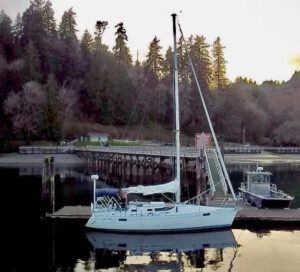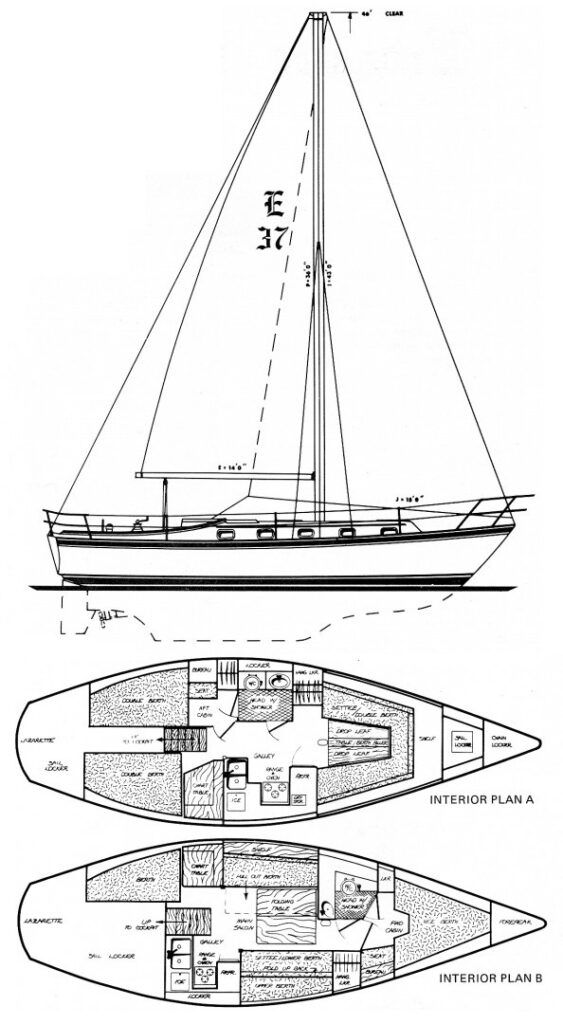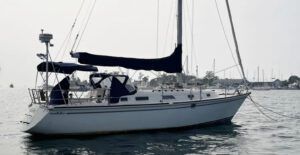In a search for a budget cruiser, Practical Sailor has made it a point over the years to look at used boats from a prior era to find deals you might consider. For this round, we went back to a list we established in 2009, and updated it by adding two boats that make our cut—the Beneteau Oceanis 350 and the Pearson 37-2. Thus, this piece will examine a field of used sailboats costing less—and often way less than— $50K and built in the 1980s. Older boats are getting increasingly long in the tooth and more difficult to maintain and insure. Owners of even newer boats are often having to go the route of the self-insured. The insurance industry has changed radically in recent years.
We narrowed the field to boats with sufficient accommodations for four people and a draft of less than 6 feet. One way to approach a used-boat search is to look for sailboats with informed, active owners associations, a brand with a good reputation, and high resale values. Practical Sailor’s quest for recession-proof cruisers led us to the Beneteau Oceanis 350, Bristol 35.5C, Endeavour 37, S2 11.0, O’Day 37, Niagara 35, Pearson 37-2, C&C Landfall 38, and the Tartan 37.

Let’s say you’re looking to buy a boat for summer cruising along the coastal U.S. or on the Great Lakes, one that, when the time is right, is also capable of taking you safely and efficiently to Baja or the Bahamas, and perhaps even island-hopping from Miami to the West Indies. Like most of us, your budget is limited, so a new boat is out of the question. Let’s set more specifics:
- Passes a thorough survey by a respected surveyor and has been upgraded to meet current equipment and safety standards. (These are old boats, after all, prone to all sorts of potentially serious problems.)
- Fun to sail inshore (which means not too heavy and not too big).
- Sufficient accommodations and stowage to cruise four people for two weeks.
- Popular model (active owners support group for help and camaraderie) with decent resale value
- (Way) under $50,000.
- Monohull (multihulls violate the price cap, anyway).
- Draft of less than 6 feet (for the islands, mon).
As we culled through the choices, we found a fairly narrow range of boat lengths and vintages that satisfy the criteria. Of course, there always are exceptions, but basically it is this: 35- to 38-footers built in the 1980s. Bigger or newer boats that meet our criteria likely cost more than $50,000 (But don’t get discouraged. Some smart shopping might find good examples for less).
Our list of nine models were built by reputable companies in the U.S. or Canada, with underwater configurations ranging from full keels with attached rudders to fin keels and spade rudders. Displacements are mostly moderate.
Below we present notes on the finalists.
BENETEAU OCEANIS 350

This modern sloop was designed by Philippe Briand and produced from 1986 to 1993. Its iron keel is not as preferable as lead, which won’t rust and is denser. Compared to, say, the Pearson 36-2, the Oceanis 350 is almost 5,000 lbs. lighter, and so the sailplan is correspondingly smaller. With its modern underbody, it sails well upwind. Typical of French designs of that period, there are several accommodation plans available: two or three sleeping cabins. As the world’s largest boatbuilder, Beneteau is a master at mass production and economizing costs, keeping initial sales prices relatively low. Despite that, we found a number of late 1980s Oceanis 350s selling for around $45,000, suggesting they retain their value. See the listing for the boat shown here.
| Beneteau Oceanis 350 | |
|---|---|
| LOA: | 33.83 ft / 10.31 m |
| LWL: | 29.83 ft / 9.09 m |
| S.A. (reported): | 471.00 ft² / 43.76 m² |
| Beam: | 11.25 ft / 3.43 m |
| Displacement: | 10,582.00 lb / 4,800 kg |
| Ballast: | 3,540.00 lb / 1,606 kg |
| Max Draft: | 5.16 ft / 1.57 m |
| Construction: | FG |

BRISTOL 35.5C

Bristol Yachts was founded by Clint Pearson after he left Pearson Yachts in 1964. His early boats were Ford and Chevy quality, good but plainly finished. Over the years this changed, so that by the late 1970s and early 1980s, his boats were between Buicks and Cadillacs in overall quality. This includes the Ted Hood-designed 35.5C. It’s a centerboarder with a draft from 3 feet, 9 inches board up to 9 feet, 6 inches board down; a keel version also was available (named without the “C”).The solid fiberglass hull was laid up in two halves and then joined on centerline. It had an inward-turning flange on the hull, superior to the more common shoebox hull-to-deck joint. The 35.5C is very good in light air, but tender in a breeze. Models from 1983-85 sell in the mid to high $40s. See a typical listing here.
| Bristol 35.5 | |
|---|---|
| LOA: | 35.50 ft / 10.82 m |
| LWL: | 27.50 ft / 8.38 m |
| S.A. (reported): | 602.00 ft² / 55.93 m² |
| Beam: | 10.83 ft / 3.30 m |
| Displacement: | 15,000.00 lb / 6,804 kg |
| Ballast: | 6,500.00 lb / 2,948 kg |
| Max Draft: | 5.75 ft / 1.75 m |
| Construction: | FG/balsa cored deck |

ENDEAVOUR 37

The Endeavour Yacht Corp. was founded in 1974, and its first model was a 32-footer, built in molds given to it by Ted Irwin. Yup, the Endeavour 32 has the same hull as the Irwin 32. Its second model was the Endeavour 37, based on a smaller, little known Lee Creekmore hull that was cut in half and extended. Its not the prettiest boat in the world, and not very fast, but heavily built. Owners report no structural problems with the single-skin laminate hull. It has a long, shoal-draft keel and spade rudder. What helped popularize the Endeavour 37 was the choice of layouts: an aft cabin with a quarter berth, a V-berth and quarterberth, and a (rare) two aft-cabin model. Production ended after 1983. Prices range from the mid $20s to mid $30s—a lot of boat for the money. See a typical listing here.
| Endeavor 37 | |
|---|---|
| LOA: | 37.00 ft / 11.28 m |
| LWL: | 30.00 ft / 9.14 m |
| S.A. (reported): | 574.00 ft² / 53.33 m² |
| Beam: | 11.58 ft / 3.53 m |
| Displacement: | 20,000.00 lb / 9,072 kg |
| Ballast: | 8,000.00 lb / 3,629 kg |
| Max Draft: | 4.50 ft / 1.37 m |
| Construction: | FG solid laminate |

O’DAY 37

This low-profile family sloop was second only to the O’Day 40 in number of boats built by O’Day under its various owners. Founded by Olympic gold-medalist George O’Day to build one-designs and family daysailers, subsequent ownership expanded into trailer sailers and small- to medium-size coastal cruisers. Like the others, the 37 was designed by C. Raymond Hunt Associates. The center-cockpit is a bit unusual but some prefer it. The cruising fin keel and skeg-mounted rudder are well suited to shallow-water cruising, and the generous beam provides good form stability. The hull is solid fiberglass, and the deck is cored with balsa. Owners report it is well balanced and forgiving. Early 1980s models are on the market for less than $40,000, most asking in the mid-$30s. See a typical listing here.
| O'Day 37 | |
|---|---|
| LOA: | 37.00 ft / 11.28 m |
| LWL: | 30.33 ft / 9.24 m |
| S.A. (reported): | 594.00 ft² / 55.18 m² |
| Beam: | 11.33 ft / 3.45 m |
| Displacement: | 14,000.00 lb / 6,350 kg |
| Ballast: | 6,000.00 lb / 2,722 kg |
| Max Draft: | 5.00 ft / 1.52 m |
| Construction: | FG w/balsa cored deck |

PEARSON 37-2

Pearson Yachts of Rhode Island was a major builder from the mid-1950s until its closure in 1986. It commissioned well-known designers like Carl Alberg and Philip Rhodes before moving in-house with Bill Shaw. A keel/centerboard and wing keel were options. Production ran from 1985-1990. Construction is typical of the era with the fiberglass hull and deck cored with end-grain balsa wood, replaced with plywood in the area of deck penetrations such as cleats and stanchions. We found a number of boats for sale ranging from $32,000 to $45,000. See a typical listing here.
| Pearson 37-2 | |
|---|---|
| LOA: | 37.42 ft / 11.41 m |
| LWL: | 29.58 ft / 9.02 m |
| S.A. (reported): | 661.00 ft² / 61.41 m² |
| Beam: | 12.33 ft / 3.76 m |
| Displacement: | 16,000.00 lb / 7,257 kg |
| Ballast: | 6,000.00 lb / 2,722 kg |
| Max Draft: | 4.67 ft / 1.42 m |
| Construction: | FG |

S2 11.0

Built in Holland, Michigan, the S2 sailboat line emerged in 1973 when owner Leon Slikkers sold his powerboat company, Slickcraft, to AMF and had to sign a non-compete agreement. The 11.0 was the largest model, introduced in 1977. Designer Arthur Edmunds resisted some of the bumps and bulges indicative of the International Offshore Rule (IOR), but still gave the 11.0 fine ends, and a large foretriangle. Two accommodation plans were offered: an aft cockpit with conventional layout of V-berth, saloon, and quarter berth and galley flanking the companionway; and an unusual center-cockpit layout with V-berth forward immediately followed by opposing settees, and then galley and head more or less under the cockpit. The master suite is in the aft cabin. The hull is solid fiberglass and includes the molded keel cavity for internal ballast; the deck is balsa-cored. Overall construction quality is rated above average. In production from 1977 to 1987, prices range from about $25,000 to $40,000. See a typical listing here.
| S2 11.0 Basics | |
|---|---|
| LOA: | 36.00 ft / 10.97 m |
| LWL: | 28.25 ft / 8.61 m |
| S.A. (reported): | 625.00 ft² / 58.06 m² |
| Beam: | 11.92 ft / 3.63 m |
| Displacement: | 16,000.00 lb / 7,257 kg |
| Ballast: | 6,000.00 lb / 2,722 kg |
| Max Draft: | 5.50 ft / 1.68 m |
| Construction: | FG/balsa cored deck |

NIAGARA 35

Austria-born George Hinterhoeller emigrated to Canada in the 1950s and began doing what he did all his life: build boats, first out of wood, then fiberglass composite. He was one of four partners who formed C&C Yachts in 1969. He left in 1975 to again form his own company, Hinterhoeller Yachts. The company built two distinct model lines: the better known Nonsuch line of cruising boats with unstayed catboat rigs, and the Niagara line. About 300 Niagara 35s were built between 1978 and 1995. With its moderately heavy displacement, conservative sailplan, and relatively large keel, the Niagara 35 is not a speed demon, and does not point as high as a boat with a deep, narrow fin keel. But thats not what were after here. The 35’s specs are just about what we want for a versatile cruising boat. Note the departure from the traditional V-berth and the offset companionway to allow a full U-shaped galley. Under way, owners say performance picks up quickly as the breeze fills in. If the sailplan were larger, for improved light-air performance, you’d have to reef sooner, and reefing is work. The Niagara 35 is a handsome, classically proportioned cruising sloop from one of the best builders of production boats in North America. It is not considered big enough these days to be a circumnavigator, but certainly large enough for a couple to leisurely cruise the Bahamas, Caribbean Sea, and South Pacific. We found asking prices ranging from around $24,000 to $39,000. See a typical listing here.
| Niagara 35 | |
|---|---|
| LOA: | 35.08 ft / 10.69 m |
| LWL: | 26.67 ft / 8.13 m |
| S.A. (reported): | 598.00 ft² / 55.56 m² |
| Beam: | 11.42 ft / 3.48 m |
| Displacement: | 14,000.00 lb / 6,350 kg |
| Ballast: | 5,500.00 lb / 2,495 kg |
| Max Draft: | 5.17 ft / 1.58 m |
| Construction: | FG |

C&C LANDFALL 38

Like the Niagara, the Landfall 38 featured a fairly long, shallowish fin keel and a spade rudder, with a displacement/length ratio of 272. Notable drawbacks: a V-berth that becomes quite narrow forward, and a hull that rises so quickly aft that C&Cs normal gas bottle stowage at the end of the cockpit is eliminated. This on a cruising boat no less, where a hot meal is often the highlight. Despite being 2,000 pounds heavier than the C&C 38, the Landfall 38 is still a quick boat. Its old PHRF rating of 120 is just a little higher than the Cal 39 at 114, and less than the Tartan 37 we’ll look at next.
The mast is a little shorter than that of the C&C 38, but as with most boats of the IOR era, the Landfall 38 has a large foretriangle of 385 square feet. A 150-percent genoa measures 580 square feet, which is a handful for older crew. Roller furling with maybe a 135 percent genoa would be a logical way to minimize the effort required to tack this boat. That said, the Landfall 38 is an excellent family boat and coastal cruiser. Its popularity in the Great Lakes region is not surprising. Island hopping to the Caribbean is also within reach, but any longer cruises will likely require more tank capacity and stowage. Standard tankage is 104 gallons water and 32 gallons of fuel. Prices range from around $30,000 to $45,000 asking. See a typical listing here.
| C&C Landfall 38 | |
|---|---|
| LOA: | 37.58 ft / 11.45 m |
| LWL: | 30.17 ft / 9.20 m |
| S.A. (reported): | 648.00 ft² / 60.20 m² |
| Beam: | 12.00 ft / 3.66 m |
| Displacement: | 16,700.00 lb / 7,575 kg |
| Ballast: | 6,500.00 lb / 2,948 kg |
| Max Draft: | 5.00 ft / 1.52 m |
| Construction: | FG w/balsa cored hull & deck |

TARTAN 37

In the early years of fiberglass boat construction, the major builders—Columbia, Cal, Morgan, Tartan, and others—commissioned well-known naval architects to design their models. Tartan Yachts of Grand River, Ohio, relied almost exclusively on the prestigious New York firm of Sparkman & Stephens; they’d drawn the Tartan 27 for the company’s antecedent, Douglass & McLeod, and were called on again to design the Tartan 37, which had a very successful production run from 1976 to 1988.
The Tartan 37 has the modern, clean, strong lines that typified S&S designs. The bow is raked, and the angle of the reverse transom is in line with the backstay—an easily missed detail that nevertheless affects the viewers impression of the boat.
From the beginning, Tartan Yachts set out to build boats of above average quality, and this can be seen in both the finish and fiberglass work. Some unidirectional rovings were incorporated in the hull laminate to better carry loads; like the vast majority of boats of this era, the resin was polyester. Vinylester skin coats, which better prevent osmotic blistering, had yet to appear. Some print-through is noticeable, more on dark-color hulls. The hull and deck are cored with end-grain balsa, which brings with it our usual warnings about possible delamination.
Under sail, the Tartan 37 balances and tracks well. As noted earlier, it’s not a fireburner, but not a slug either. The deep fin-keel version points a little higher than the keel/centerboard because it has more lift, however, the deep draft of 6 feet, 7 inches is a liability for coastal cruising. Because of the large foretriangle and relatively small mainsail, tacking a genoa requires larger winches and more muscle than if the relative areas of the two were reversed. For relaxed sailing, jiffy reefing of the main and a roller-furling headsail take the pain out of sail handling. See a typical listing here.
| Tartan 37-2 | |
|---|---|
| LOA: | 37.21 ft / 11.34 m |
| LWL: | 30.83 ft / 9.40 m |
| S.A. (reported): | 673.00 ft² / 62.52 m² |
| Beam: | 12.33 ft / 3.76 m |
| Displacement: | 15,200.00 lb / 6,895 kg |
| Ballast: | 6,500.00 lb / 2,948 kg |
| Max Draft: | 6.83 ft / 2.08 m |
| Construction: | FG |








































